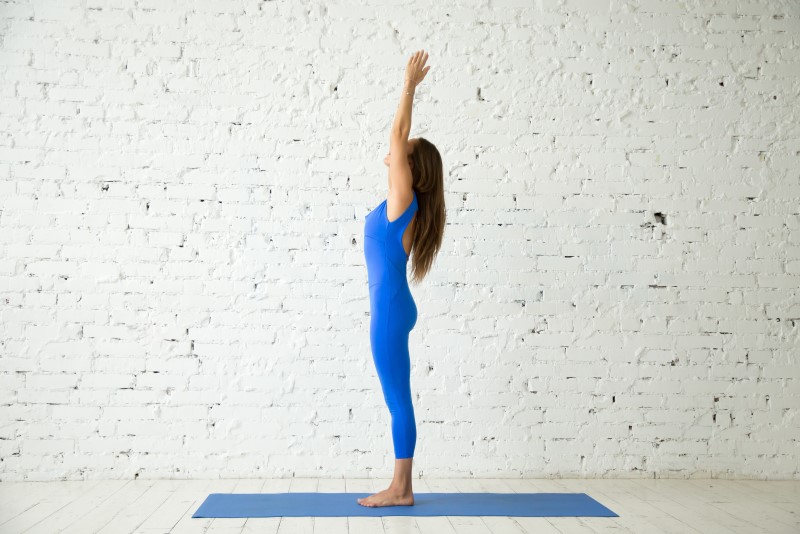First of all, congratulations on deciding to enter the world of yoga. From science to spirituality, every field has acknowledged the superpowers of yoga. As a beginner, it might be hard to decide where to start, but don’t worry, we have 9 easy yoga poses for beginners at home. So, get your yoga mats ready as we explore these beginner-friendly exercises.
Yoga for Beginners: Poses
As a beginner, you might have your own set of confusions. You might wonder if you will be able to continue this practice in the long run or if you are even fit for doing yoga. However, you need to know there are no prerequisites for yoga. You can read our article “7 Yoga Myths to Stop Believing Today” for better understanding.
The 9 beginner-friendly yoga poses we are discussing below have been charted out with careful considerations. We have leveraged the science of feel-good hormones, ensuring a proper mix of simple and intermediate poses. We have also made sure to explain yoga for beginners in a step-by-step manner. This way, you won’t get bored easily and will keep going in the long run.
1. Mountain Pose: Yoga for Beginners (Easy)

Instructions:
- Stand tall with your feet together, ensuring the weight is evenly distributed on all four corners.
- Engage your thighs, lifting your kneecaps and firming your leg muscles.
- Lift your chest, broaden your collarbones, and extend your arms overhead with palms facing each other or hands pressed together.
- Keep your gaze forward and breathe deeply, finding strength and stability in the pose.
Precautions:
- Avoid locking your knees; keep a slight bend to protect the joints.
- If you have balance issues, stand near a wall or use a prop for support.
Benefits:
- Improves posture and body awareness.
- Strengthens thighs, knees, and ankles.
- Enhances concentration and focus.
2. Child’s Pose (Balasana): Yoga for Relaxation

Instructions:
- Kneel on the mat with knees apart and big toes touching.
- Sit back on your heels, extending your arms forward or resting them by your sides.
- Allow your forehead to rest on the mat, feeling a gentle stretch in your back.
- Breathe deeply, relaxing into the pose.
Precautions:
- If you have knee issues, use a folded blanket under your knees.
- Avoid this pose if you have a recent knee or ankle injury.
Benefits:
- Stretches the back, hips, and thighs.
- Relieves neck and lower back tension.
- Calms the mind and promotes relaxation.
3. Seated Easy Pose (Sukhasana): Simple Pose for Beginners

Instructions:
- Sit cross-legged with a straight spine.
- Rest your hands on your knees and close your eyes, focusing on your breath.
- Keep your shoulders relaxed and chin parallel to the floor.
Precautions:
- If you have hip or knee discomfort, sit on a cushion or folded blanket.
- Adjust the cross of your legs if you feel any pain or numbness.
Benefits:
- Cultivates calmness and mindfulness.
- Opens the hips and promotes good posture.
4. Warrior II (Virabhadrasana II): Beginner’s Yoga for Strength

Instructions:
- Step one foot back, keeping the front knee bent and aligned over the ankle.
- Extend your arms parallel to the floor, gazing over the front fingertips.
- Feel the strength and power in your legs and the openness in your chest.
Precautions:
- Ensure the front knee doesn’t go beyond the ankle to prevent strain.
- If you have high blood pressure, avoid raising your arms overhead.
Benefits:
- Strengthens legs, arms, and core.
- Improves concentration and stamina.
- Stretches the hips and chest.
5. Downward-Facing Dog: Feel-Good Stretch

Instructions:
- Start on your hands and knees, lift your hips toward the ceiling, and straighten your legs.
- Ground through your palms and heels, creating a V-shape with your body.
Precautions:
- Keep a slight bend in your knees if you have tight hamstrings.
- Avoid if you have wrist or shoulder injuries.
Benefits:
- Stretches the entire body, particularly the hamstrings and calves.
- Builds strength in the arms, shoulders, and core.
- Calms the mind and improves circulation.
6. Chair Pose (Utkatasana): Yoga for Beginners (Weight Loss)

- Stand with feet hip-width apart.
- Take a deep breath and raise your arms overhead.
- Slowly exhale and bend knees as if sitting in a chair.
- Engage your core and hold, then return to standing.
Precautions:
- Avoid it if you have knee issues.
- Start with shallow bends and gradually deepen.
Benefits:
- Strengthens thighs, glutes, and core.
- Increases heart rate for calorie burn and promotes weight loss.
7. Boat Pose (Navasana): Weight Loss Yoga

- Sit with your knees bent, make sure your feet are flat.
- Lean back slightly and try to lift your feet, extend your arms forward.
- Form a V-shape with the body and stay in this position for a while.
- Relax and come lay back.
Precautions:
- Support lower back with hands if needed.
- Avoid it if you have lower back issues.
Benefits:
- Targets abdominal muscles and tones them up for a chiseled look.
- Improves digestion and stimulates metabolism.
8. Seated Forward Bend: Yoga for Lower Back

Instructions:
- Sit with legs extended in front and hinge at your hips to reach toward your toes.
- Relax your neck and shoulders, feeling a gentle stretch in your hamstrings and spine.
- Breathe deeply to enhance the calming effect.
Precautions:
- Bend your knees slightly if you feel strain in your lower back.
- Avoid forcing the stretch; go only as far as comfortable.
Benefits:
- Stretches the spine, hamstrings, and lower back.
- Calms the nervous system and promotes relaxation.
9. Cat-Cow Stretch: Beginner-Friendly Yoga for Flexibility

Instructions:
- Start on your hands and knees, moving between arching your back (Cow) and rounding it (Cat).
- Coordinate movement with your breath, promoting flexibility in the spine.
Precautions:
- Keep the movements slow and controlled to avoid strain.
- If you have neck issues, keep your gaze neutral.
Benefits:
- Promotes spinal flexibility and mobility.
- Strengthens the core and improves posture.
- Releases tension in the back and neck.
Yoga for Beginners: Online
As a beginner, finding a yoga routine that is engaging and effective is important. Keeping this in mind, Yuvaap has tailored a Yoga for beginners: Routine. Here we have suggested yoga poses based on specific concerns. Our expert has showcased and explained each yoga pose.
You can easily filter out the yoga poses that resonate with your concern and start practising at your own pace. This way, you can ensure accuracy and effectiveness of your yoga practice.
Check Out – Yoga Session For Beginners
Beginners Yoga: Suggestions and Precautions
The whole world is aware of the amazing benefits of yoga poses. From stress reduction to improving flexibility, yoga serves every purpose. But as a beginner, you must ensure several things before starting yoga. Here are some suggestions that can help you align with yoga in a better way.
1 – Don’t Get Overwhelmed
There are millions of videos of people showcasing their yoga expertise.While new studies keep showing amazing benefits of yoga, it’s important not to go overboard as a beginner. Start with slow and measured steps and slowly as you get comfortable then only experiment with new styles.
2- Patience is the Key
You won’t be a yoga master in a single day. Yoga is all about patience. Don’t force your body beyond its limits. Becoming a yoga expert takes years of practice, so be patient and keep practicing.
You can start with basic yoga poses and then gradually move toward advanced poses. Within 2-3 months you will start experiencing changes regarding flexibility.
3 – Knowledge is Power
It is important to understand that yoga is not just a physical activity. It’s a way of life. In order to get optimum benefits from yoga, you need to know it better. You can check out the below-linked discussion with Yoga Expert “Meenakshi Mahalwal” who believes yoga can even help in building healthy relationships.
4- Safety Is Prime
Though yoga is all gold and glitter, at times we need to do things according to our body. If you have any underlying health condition, then you must consult with a healthcare provider before starting any practice. There are various kinds of yoga for various needs, be it pregnancy or any other condition. Make sure to make your selection of yoga sequences wisely.
Life is all about making choices that make us grow as an individual. Yoga is the best way to invite mental, physical, and spiritual growth into your life.
As you begin the practice of yoga, there might be challenges and questions in your mind. You might even get overwhelmed by the sea of information available online. But it’s always smart to start with simple steps and then advance gradually.
These 9 easy yoga poses for beginners at home can help you get over your dilemma and prepare you for a spectacular start. We hope your journey with yoga continues for a lifetime. Wishing you all the best!
FAQs
References
https://www.ncbi.nlm.nih.gov/pmc/articles/PMC3193654/
https://www.webmd.com/fitness-exercise/how-to-do-cow-yoga-pose
https://www.webmd.com/fitness-exercise/how-to-do-childs-pose

Mr. Vijay Kumar Pandey is an eminent Yoga teacher with 15 years of experience. He excelled himself in Iyengar Yoga under the guidance of revered master BKS Iyengar Read More


